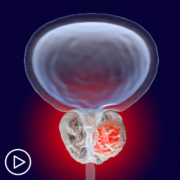Targeted Prostate Cancer Therapies vs. Chemotherapy: What’s the Difference?
Targeted Prostate Cancer Therapies vs. Chemotherapy: What’s the Difference? from Patient Empowerment Network on Vimeo.
Targeted prostate cancer therapies and chemotherapy are both available options to treat patients with prostate cancer. Dr. Sumit Subudhi discusses the differences between these two forms of treatment, including their effectiveness and side effects.
Dr. Sumit Subudhi is a Medical Oncologist at The University of Texas MD Anderson Cancer Center.
See More From INSIST! Prostate Cancer
Related Resources

Prostate Cancer: How to Know If Your Treatment Plan Is Working |

Why Prostate Cancer Patients Should Consider Participating in a Clinical Trial |

|
Transcript:
Katherine:
Let’s turn to targeted therapies. How exactly do they work?
Dr. Subudhi:
Yeah. So, this is a form of personalized medicine. So, what you’re doing is you’re looking at the patient’s cancer, either their inheritable cause of genetic causes or the somatic. And then you’re saying, oh, wait, they have a genetic defect in a DNA machine. So, let’s use the PARP inhibitor, which also targets the DNA machinery.
And these are the cancer cells that are most likely to be susceptible to PARP inhibition. And actually, the cancer cells will die from it. Whereas if a patient has a normal DNA machinery, the PARP inhibitors will actually not have any effect on the cancer.
They’re given, actually, orally twice a day. The two drugs are rucaparib and Olaparib that have been FDA approved for this indication.
Katherine:
How do these newer treatments differ from traditional chemotherapy?
Dr. Subudhi:
So, with chemotherapies, at least in prostate cancer, they’re given intravenously every three weeks. And the goal of the chemotherapies, they are actually designed to kill any actively dividing cell in the body.
And the problem is it’s not just cancer cells that are actively dividing in our body. For example, with the chemotherapy such as docetaxel or cabazitaxel, that’s used in prostate cancer – their brand names are Taxotere and Jevtana – these chemotherapies will also affect hair loss. Why? Because hair grows really fast. And in fact, I need a haircut every three to four weeks, which my wife has been helping me with.
So, the chemotherapies are targeting all actively dividing cells, and that’s why you also get nausea vomiting, because the cells of our GI tract are also affected by that. So, chemotherapies are not personalized. They’re there to kill actively dividing cells. Luckily prostate cancer divides a lot more quickly than any other cell in our body, and that’s why they’re susceptible to chemotherapy.
Katherine:
And as far as the targeted therapies, Dr. Subudhi, are there side effects with those?
Dr. Subudhi:
Yeah, there are. One of the most predominant side effect is actually anemia. And so, that’s when the red blood cells in our body are lower than usual. And so, that’s one of the major side effects for PARP inhibitors. But in addition, you can have nausea, vomiting, and diarrhea as other side effects with the PARP inhibitors.










